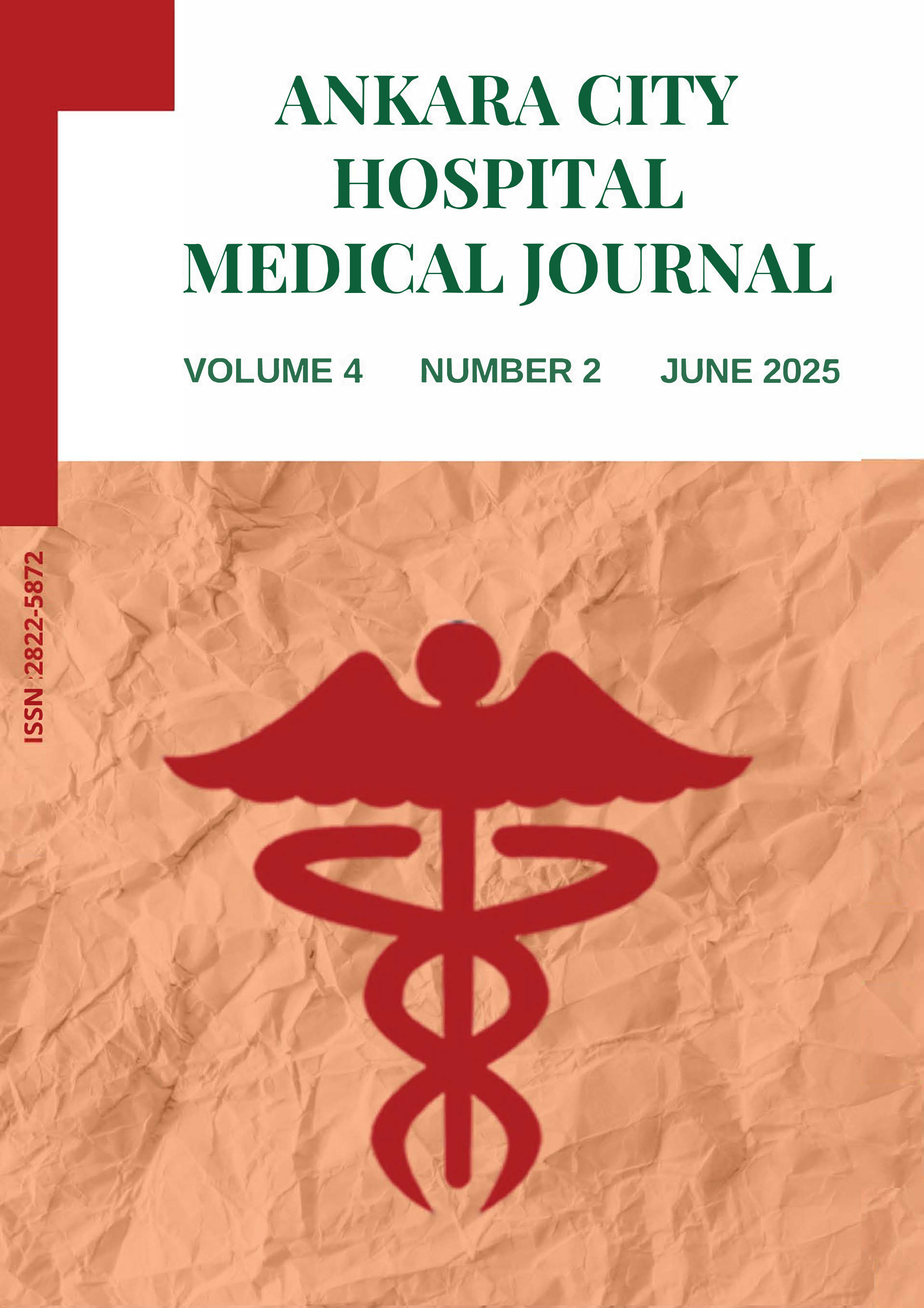
Volume: 4 Issue: 1 - March 2025
| 1. | Full Issue Pages I - II |
| RESEARCH ARTICLE | |
| 2. | The Impact of Sarcopenia on Post-COVID Pulmonary Sequelae Murathan Koksal, Yusuf Dedecan, Mehmet Kutlu doi: 10.5505/achmedj.2025.09709 Pages 1 - 9 INTRODUCTION: Following COVID-19 pneumonia, some patients experience symptoms such as weakness, fatigue, dyspnea, exertional dyspnea, and a persistent cough. This condition is defined as post-COVID-19 syndrome. Residual chest CT findings can be detected in some of these patients. Sarcopenia, a concept reflecting skeletal muscle mass loss, is a condition that occurs during the development of many diseases. This study aims to investigate the impact of sarcopenia on pulmonary sequelae following COVID-19 infection. METHODS: A total of 142 patients were included in our study. Among them, 73 patients had post-COVID sequelae on CT scans and served as the patient group, while 69 patients had no sequelae on CT scans and formed the control group. Muscle measurements derived from thoracic CT scans were manually obtained using PACS software. The areas and densities of the total pectoral muscles at the upper half level of the T4 vertebra and the paraspinal muscles at the lower half level of the T12 vertebra were recorded. RESULTS: There were no statistically significant differences in the mean values of T4 vertebra total pectoral muscle area, T12 vertebra paraspinal muscle area, T4 vertebra pectoral muscle density and T12 vertebra paraspinal muscle density between the groups. However, both the patient and control groups were sarcopenic according to reference values DISCUSSION AND CONCLUSION: In our study, we could not find an association between lung CT findings, respiratory symptoms of the patients, and sarcopenia, which was the main focus. We attributed this to the separate mechanisms and pathophysiological processes of sarcopenia and pulmonary sequelae. |
| 3. | Bladder Exstrophy Reconstruction Without Osteotomy; Evaluation of 50 Cases Süleyman Tağcı, Gökhan Demirtaş, Bilge Karabulut, Tugrul Tiryaki doi: 10.5505/achmedj.2025.85057 Pages 10 - 14 INTRODUCTION: To evaluate the outcome of our patients who underwent BE (bladder exstrophy)repair without osteotomy and to determine whether they are continent, upper urinary system functions, and complication rates. METHODS: The data of 50 patients who applied to our clinic due to bladder exstrophy between 2010 and 2022 were analyzed retrospectively. The gender of the patients, the age of the operation, the surgical interventions, the complications detected, whether they were continent or not, and their upper urinary system functions were recorded. RESULTS: The data of the 50 patients diagnosed with classical bladder exstrophy were evaluated and included in the study. Nine of these patients were female, and 41 were male. The patients’ mean age was 71.2 months(6-264 months). The mean follow-up period was determined to be 70.8 months. Bladder closure was performed in 13 of 50 patients, bladder closure + bladder neck repair + epispadias repair was performed in 29 patients, and augmentation was performed for eight patients. Augmentation was recommended for five patients in the follow-up, but patients did not accept it. Skin dehiscence occurred in 2 patients, and a primary suture was performed for them. Three patients were reoperated for bladder dehiscence. During the follow-ups, cystolithotripsy was performed in 3 patients,and csytolitotomy was performed in 2 patients. Bladder dehiscence developed in 1 patient after csytolitotomy, and he was operated on.25 of the 50 patients included in the study were under five years of age. The continence status of the remaining 25 patients was evaluated. Fifteen (60%) of 25 patients were found to be continent. DISCUSSION AND CONCLUSION: Although strong advocates of bladder exstrophy repair with osteotomy exist, we recommend repair without osteotomy as an easy-to-apply and low-complication approach. |
| 4. | Investigation of Prohibitin Levels in Preeclampsia Cases: A Case Control Study from a Tertiary Hospital Hasan Burak Keser, Funda Gülcü Bulmuş, Salih Burcin Kavak, Ebru Celik Kavak doi: 10.5505/achmedj.2025.08379 Pages 15 - 21 INTRODUCTION: To evaluate the relationship between the effects of prohibitin at the cellular level and the pathophysiology of preeclampsia. METHODS: This study included a total of 120 patients who presented to our clinic at 20–41 weeks of gestation. The participants were divided into three groups: 40 pregnant women with preeclampsia with severe features, 40 pregnant women with preeclampsia, and 40 healthy pregnant women. To measure serum prohibitin levels, 10 cc of venous blood was collected from each participant, and comparisons were made between the groups. RESULTS: Serum prohibitin levels were significantly higher in pregnant women with preeclampsia with severe features and preeclampsia compared to the control group (p<0.001 for both). DISCUSSION AND CONCLUSION: Prohibitin levels were found to be significantly increased in pregnant women with preeclampsia with severe features and those with preeclampsia compared to healthy pregnant women, suggesting that prohibitin may serve as a marker of preeclampsia. |
| 5. | The value of the second trimester glucose-to-lymphocyte ratio in predicting fetal loss at late preterm and term pregnancies Onur Osman Özkavak, Dilek Şahin doi: 10.5505/achmedj.2025.69875 Pages 22 - 26 INTRODUCTION: This study aimed to determine whether the second-trimester glucose-to-lymphocyte ratio (GLR) can predict intrauterine fetal demise (IUFD) at late preterm and term gestations. METHODS: A retrospective cross-sectional design was employed. Pregnant women aged 18–45 who delivered at our tertiary hospital between January 2023 and December 2024 were screened. Those diagnosed with IUFD at or beyond 34 weeks of gestation comprised the case group, while two healthy pregnant women of similar age and body mass index for each case served as the control group. Laboratory parameters from the 20th–24th weeks, including hemoglobin, white blood cell (WBC) count, neutrophil count, lymphocyte count, random blood glucose, and GLR, were analyzed. RESULTS: Data from 105 patients (35 IUFD, 70 controls) were included. The IUFD group had significantly lower WBC, neutrophil, and lymphocyte counts but higher glucose and GLR than controls (p<0.01). Receiver operating characteristic analysis showed an area under the curve of 0.876 (p<0.01) for GLR, with 80% sensitivity and 79% specificity at a cutoff of 0.604. DISCUSSION AND CONCLUSION: Elevated GLR in the second trimester may reflect subclinical inflammation and serve as a practical, cost-effective predictor of IUFD. Further large-scale studies are warranted to validate these findings. |
| 6. | Traces of Inflammation in Acute Appendicitis, Cholecystitis, and Diverticulitis: The Role of Biomarkers in Diagnosis Serap Ulusoy, Furkan Savaş doi: 10.5505/achmedj.2025.29484 Pages 27 - 33 INTRODUCTION: Acute appendicitis, acute cholecystitis, and acute diverticulitis are among the most common causes of acute abdominal pain, requiring early diagnosis and rapid treatment. Although imaging modalities such as ultrasonography and computed tomography play a crucial role in diagnosis, access to these methods may be limited in certain situations. Inflammatory biomarkers, including C-reactive protein (CRP), neutrophil-to-lymphocyte ratio (NLR), and delta neutrophil index (DNI), have been suggested as potential tools for differential diagnosis. This study aims to evaluate the diagnostic value of these biomarkers. METHODS: This retrospective study included 171 patients diagnosed with acute appendicitis (n=62), acute diverticulitis (n=56), and acute cholecystitis (n=53). White blood cell (WBC), neutrophil, lymphocyte, and eosinophil counts, as well as NLR, DNI, and CRP levels, were compared. Statistical analyses and ROC analysis were performed to assess the diagnostic performance of these biomarkers. RESULTS: CRP and lymphocyte levels were found to be significantly higher in the acute diverticulitis group (p < 0.05). Although DNI, NLR, WBC, and neutrophil levels were elevated in all three groups, no statistically significant difference was observed between them (p > 0.05). ROC analysis demonstrated that DNI has a moderate diagnostic potential for all three diseases, but none of the biomarkers provided high specificity. DISCUSSION AND CONCLUSION: Inflammatory biomarkers alone are not sufficient as a diagnostic tool for differentiating acute appendicitis, acute cholecystitis, and acute diverticulitis. However, CRP may be useful in assessing disease severity in patients with diverticulitis. Particularly in settings where access to imaging modalities is limited or unavailable, biomarkers such as CRP, DNI, and NLR may serve as supportive tools for diagnosis. Nevertheless, large-scale, multicenter studies are required to better define the role of inflammatory response and biomarkers in differential diagnosis and prognosis. |
| CASE REPORT | |
| 7. | A rare case of subacute thyroiditis presenting as severe neck pain and otalgia Serdar Olt, Yeşim Yıldırım doi: 10.5505/achmedj.2025.30074 Pages 34 - 37 Introduction: Subacute thyroiditis (de Quervain’s thyroiditis) is a clinical disorder characterized by inflammation of the thyroid tissue. It is the most common cause of painful thyroid disease. Although its etiology is not fully understood, it is mainly caused by viral infections. Case: A 41-year-old male patient presented to the internal medicine outpatient clinic complaining of severe pain on the left side of the face and ear a few weeks after an upper respiratory tract infection. The pain started in the neck and spread to the jaw and ear. It was continuous and seemed to increase with head movements and chewing. On physical examination, the thyroid gland was palpable and several cervical lymph nodes less than 1 cm in diameter were found. In addition, all other findings on systemic physical examination and vital signs were normal.Laboratory data revealed the following: TSH level 0.02 mIU/L (N: 0.34-5.60mIU/L), free T4 level: 2.53 ng/dL (N: 0.61-1.48 ng/dL), free T3 level 6.42 ng/L (N: 2.3-4.2 ng/L), erythrocyte sedimentation rate (ESR) 67 mm/h (N: 0-20 mm/h), C-reactive protein level (CRP) 13.6 mg/dL (0-0.8 mg/dL). Thyroid ultrasonography was non-specific. Scintigraphic examination reported a marked decrease in thyroid activity, loss of contour clarity and lack of involvement of the thyroid parenchyma. Tc99m pertechnetate showed no uptake in the thyroid gland, and scintigraphic examination revealed subacute thyroiditis. Based on the patient’s physical examination and the laboratory and imaging studies performed on him, a diagnosis of subacute thyroiditis was made. Methylprednisolone was prescribed at a dose of 32 mg, which was gradually (The dose is reduced by half at one-week intervals) reduced and then discontinued at weekly follow-up visits after diagnosis. During th e follow-up period, notable improvement was observed in the patient’s laboratory values. |
| LETTER TO THE EDITOR | |
| 8. | The Importance of Etiological Cause in Patients Admitted to The Intensive Care Unit with Acute Respiratory Distress Syndrome Korhan Kollu doi: 10.5505/achmedj.2025.24008 Pages 38 - 39 Abstract | |










